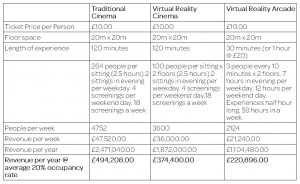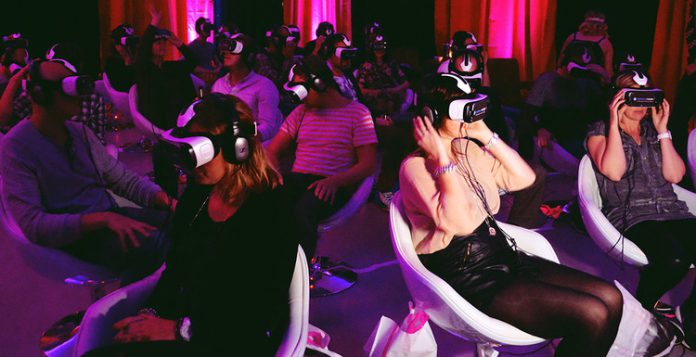How is virtual reality (VR) going to effect the cinema – Could it put them out of business? Or will they need to adapt? If so what will they look like in the future?
Times are changing. The cinema, coming into existence in the 1890’s has had many challenges to its revenue, from such technology as the TV, the DVD and lately streaming services. But all these have emulated the cinema experience as the benchmark. But never has the cinema had such a disruptive technology come along that that could fundamentally change its nature (people starring in one direction at a large screen.) VR is progressing fast and as more content emerges, it becomes better at real-time rendering and more comfortable its going to press and squeeze at the cinema forcing it to adapt.
So what are we seeing as the start of this?
Virtual Reality Cinema: The aptly named “Virtual Reality Cinema” is a company currently offering screenings in Amsterdam. Gone are the traditional red cinema chairs and in are 360 degree rotating chairs.
VR is a lone pursuit. Both image and sound are delivered exclusively in relation to your head movement and can only be seen/heard by you. So what is the point of going to a place such as a cinema to watch them? Well as humans we are gregarious creatures in need of social interaction. The traditional cinema experience is a relatively lone pursuit when the lights go down, yet we enjoy the simple act of getting out the house, meeting up and being able to chat afterwards about what has been seen.
Imax are teaming up with Starbreeze, a company creating the StarVR head-mounted display (HMD)with impressive specs (5,120 x 1,440 pixel resolution and 210 degrees FOV) far beyond what the Oculus Rift and HTC Vive deliver today. Initially it is unclear on how they intend to use this, whether for advertising and for supportive experiences to their main Imax experiences, or for stand alone experiences. Investing in cutting edge VR technology will be the strategy of many cinemas so they can stay one step ahead of the consumer market delivering a quality of experience that you won’t be able to get at home, at least for many years to come.
Virtual Reality Arcade: New companies such as The Void and Vizuality Studio are delivering large scale experiences with head and body tracking. The Ghostbusters: Dimension experience by The Void has just launched in New York. A mere 10 minute experience, but a clear sign of what is to come. Multiple users can enter into the experience at the same time and interact with physical sets such as doors (hyper reality). Also delivered can be additional sensory experience such as heat, wind and smell. This is a convergence between theatre, games, cinema and arcades. The possibilities of what you can do are vast.

What do the economics of these alternatives look like?


The beauty for film industry executives is that you can pack people in like sardines at traditional cinemas. For VR you need at the very least some space for head movement and an ability to look in all directions. This utilises more space, however you don’t need such high ceilings as in cinemas for tiered seating and can therefore have two floors in the same space.
For the arcade style experiences the larger the space the better, so more will need to be charged and the experiences themselves will be a lot shorter. Even under theses circumstances the revenue does not look nearly as attractive as the traditional cinema.
I think that what we will start to see over the coming years is the following:
1. Cinemas will start incorporating VR experiences into its facility. This will initially be gimmicky short supporting experiences to increase revenue and drive people to their cinemas such as Imax are doing.
2. We will see the rise of permanent VR Arcades which will be situated in similar places to bowling lanes and multiplexes i.e. retail parks where rent is less expensive per metre than in central city areas. This will predominantly be used for gaming experiences, but also for some more cinematic experiences. What is interesting is that while the VR arcade is less profitable on paper it is something that can not be emulated at home due to its use of hyper reality physical sets and effects. While streaming services, home tv screen, projectors and VR headsets will continue to improve and eat away at both traditional and VR cinemas profits.
3. We will see pop up cinemas in all shapes and forms, in cities, in the countryside and at festivals.
4. In the end I think you might end up with cinemas which are flexible spaces, allowing any experience to be put on. With such features as movable seating such as many new theatres do, so when new experiences come in they can alter the layout to either offer cinema or arcade style experiences, or anything in between.
VRFocus will bring you more features and observations about the world of VR in the coming weeks.















